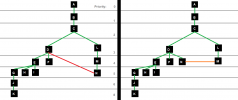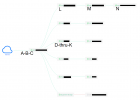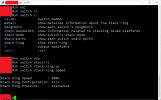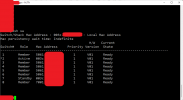DocGreen
Well-Known Member
- Reaction score
- 44
- Location
- South Bend, IN
Working for a hyper-local WISP, and was trying to complete a loop in the network to provide some redundancy. Doing so broke the internet until I removed the loop. Hoping someone here can give a little guidance. 
The image below shows what I'm trying to do. Each box is a switch (A is the gateway). The RSTP priority is shown as 1-8 for simplicity (but I understand the proper numbering/increments of 4096). The original topology is on the left, with my attempted (failed) loop shown in red. I'm trying to link switch N back to switch D to create a loop.
I think where I failed was setting RSTP priority on switch N one hop higher than switch M.
I think the correct configuration would be to set switch N's priority to the same as M, because once the loop is complete they will be the same number of hops from the router. (shown on the right)
Can anyone confirm?

The image below shows what I'm trying to do. Each box is a switch (A is the gateway). The RSTP priority is shown as 1-8 for simplicity (but I understand the proper numbering/increments of 4096). The original topology is on the left, with my attempted (failed) loop shown in red. I'm trying to link switch N back to switch D to create a loop.
I think where I failed was setting RSTP priority on switch N one hop higher than switch M.
I think the correct configuration would be to set switch N's priority to the same as M, because once the loop is complete they will be the same number of hops from the router. (shown on the right)
Can anyone confirm?







